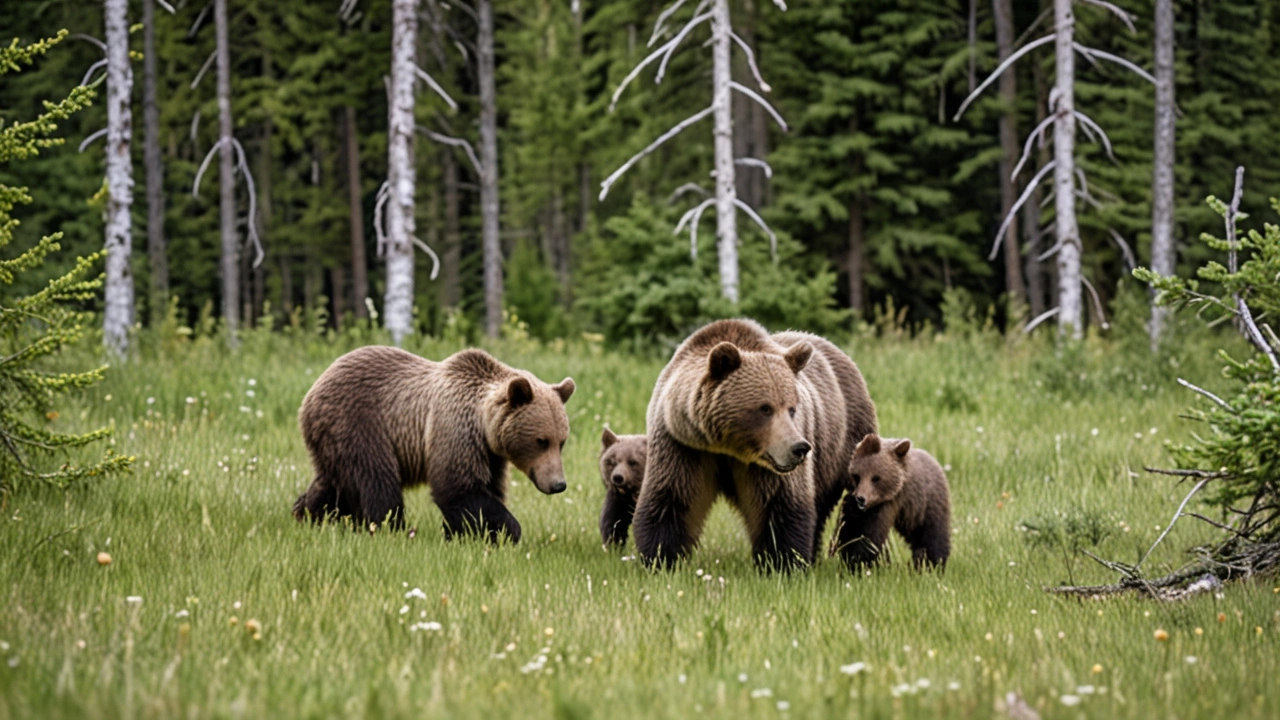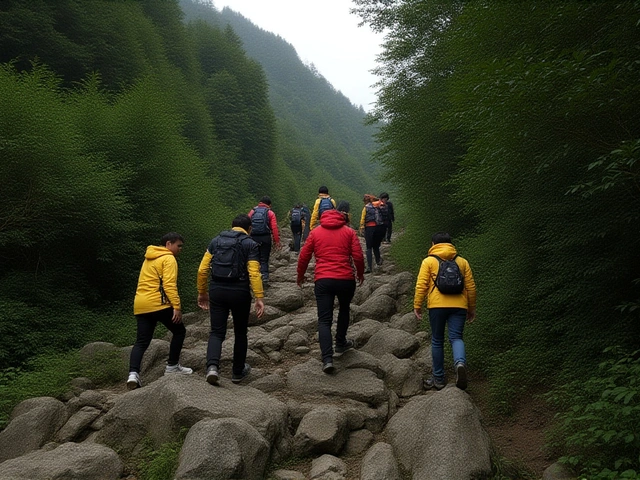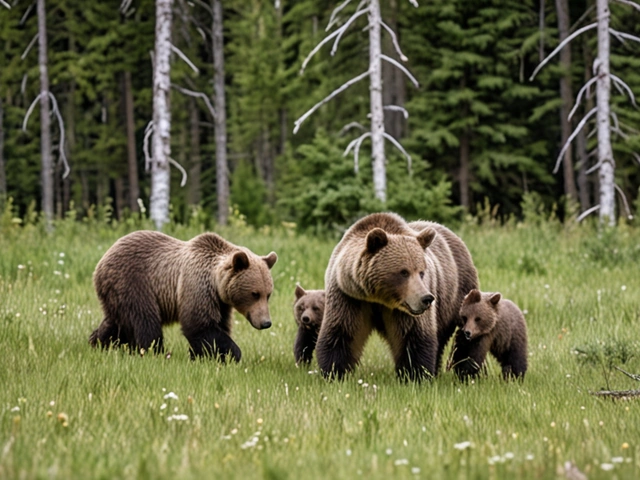In the Heart of Kananaskis Country: A Rare Adoption
In the rugged wilderness of Kananaskis Country, a remarkable event has transformed the life of a surviving grizzly cub. The story begins with a 21-year-old grizzly bear, identified by wildlife experts as Bear No. 104, who emerged from her denming hibernation this spring with three newborns in tow. However, the joys of motherhood were cut short as a large male bear is believed to have killed two of her cubs shortly after they emerged from their den. Bear No. 104's story took another unexpected turn when the surviving cub was adopted by its resilient grandmother, who had earlier experienced the tragedy of losing her own cubs. This rare adoption has piqued the interest of wildlife specialists and raised concerns about human interference in the grizzly bear community.
The Journey of Bear No. 104
Bear No. 104, a grizzly bear that has been closely monitored by researchers for many years, shows the relentless spirit of wilderness survival. This spring, she greeted the world with three tiny cubs. The joy of motherhood, however, was shattered by a brutal reality. Researchers suspect that a dominant male, adhering to the natural but harsh laws of wildlife, likely ended the lives of two of her cubs. While such tragic events are part and parcel of the wild, they leave deep impacts on the bears and resonate with anyone who follows these majestic creatures.
Grandmother Steps Up: The Adoption
Amid her grief, Bear No. 104 faced another kind of heartbreak. In June, she abandoned her surviving cubs to breed again. This act, driven by instinctual need, highlighted the often harsh conditions grizzly cubs must endure. The grandmother bear's unusual decision to adopt this orphaned cub is a remarkable twist in the story. The elder bear had her own losses earlier this year, making this newly formed bond an uplifting narrative within the grizzly community. It is a rare phenomenon for grizzly bears to adopt abandoned cubs, making this case noteworthy.
Challenges and Concerns
While the adoption of the cub by its grandmother speaks to the resilience and adaptability of nature, it also brings forth a slew of challenges. Wildlife experts are cautiously optimistic but are concerned about the proximity of humans to these bears. One of the primary fears is that the cub, without its mother, might start seeking food from humans, leading to habituation. Bears that grow accustomed to human food sources can pose significant risks, not just to themselves but also to human populations. This habituation often leads to tragic outcomes where bears have to be euthanized for public safety. Therefore, experts are advocating for minimal human interaction and stringent preventive measures.
Preserving the Natural Order
The exceptional tale of Bear No. 104 and her surviving grandcub is enchanting but also a poignant reminder of our responsibilities towards wildlife. The adoption of the orphaned cub underlines the innate strength and adaptability within the grizzly bear community, yet it also serves as a critical lesson for humans. Our role should be to ensure that these magnificent creatures can thrive in their natural habitat without intrusive intervention. The balance between appreciating wildlife and preserving their natural behavior is delicate, and incidents like this highlight the necessity for awareness and respectful distance.
A Call to Action
Moving forward, wildlife conservationists are urging the public to stay informed and be vigilant in their interactions with nature. Kananaskis Country, with its breathtaking landscapes and rich biodiversity, is not just a haven for adventure but also home to intricate ecosystems that need care and respect. The story of Bear No. 104 and her grandcub is a unique chapter in the ongoing narrative of wildlife conservation. It asks us to reflect on how we perceive and interact with nature, urging for a collective effort to safeguard these natural wonders.









13 Comments
Nature finds a way. A grizzly grandma stepping up is rare. It shows resilience. We should respect that.
This event underscores the robust genotype of our North American apex predators; the adaptive strategies employed by the matriarchic bear exemplify the superiority of continental wildlife management doctrines. The hierarchical dynamics observed are a testament to evolutionary optimization.
Romanticizing a bear’s behavior distracts from the brutal fact that most cubs never survive without human interference. The ecosystem is unforgiving, and sentimental narratives do nothing to improve survival odds.
Seeing a grandma bear adopt a cub is wild, but we gotta keep our distance. The more we hover, the higher the chance the cub learns to raid camps and that’s a recipe for disaster.
Totally agree, dude. Let’s keep the bears wild and the snacks hidden. Safety first, wildlife second.
Did you know the team has fitted the grandma with a GPS collar? 😊 They can track her moves 24/7 and ensure the cub isn’t getting too comfy around humans.
Monitoring is crucial. Less disturbance means better data and a healthier bear family.
Experts suggest leaving a 100‑meter buffer zone around known bear activity. This reduces habituation risk and protects both people and bears. 👍
Oh sure, because a neat little circle of safety will magically stop a hungry grizzly from sniffing out your leftovers. Reality check: bears love snacks.
Interesting story.
Let me unpack the layers of significance embedded in this seemingly isolated event. First, the act of intergenerational adoption among ursines is not merely a quirky footnote in wildlife folklore; it is a profound illustration of adaptive plasticity that challenges our reductive models of solitary carnivore behavior. Second, the loss of two cubs at the hands of an intruding male underscores the relentless selective pressures that sculpt genetic fitness, reminding us that nature operates without moral consideration. Third, the surviving cub’s reliance on its grandmother introduces a variable into population dynamics that could recalibrate our projections for recruitment rates in this region. Fourth, the human lens through which we view this narrative often carries an anthropomorphic bias, inadvertently framing the bears as actors in a drama rather than participants in an ecological script. Fifth, the potential for habituation to human food sources-as mentioned by the researchers-is a tangible threat, one that historically has precipitated lethal management interventions. Sixth, the deployment of GPS collars and remote monitoring technologies exemplifies the intersection of conservation science and modern telemetry, allowing us to gather longitudinal datasets that were once unimaginable. Seventh, the emotional resonance of an orphaned cub finding refuge in a familiar yet altered familial structure can galvanize public support, translating sentiment into policy advocacy. Eighth, policy responses must balance the urgency of protecting human communities with the ethical imperative to preserve natural processes, a dichotomy that often spawns contentious debate among stakeholders. Ninth, this case study could serve as a pedagogical tool in academic curricula, illustrating concepts ranging from kin selection to human‑wildlife conflict mitigation. Tenth, the geographic context of Kananaskis Country adds layers of jurisdictional complexity, involving provincial wildlife agencies, federal guidelines, and indigenous stewardship perspectives. Eleventh, the media coverage of this event, while captivating, runs the risk of oversimplification, necessitating responsible journalism that conveys nuance. Twelfth, the broader implications for climate‑induced habitat shifts cannot be ignored; as ecosystems transform, behavioral adaptations like this may become more commonplace or, conversely, may be constrained. Thirteenth, the public’s perception of bears-as symbols of wilderness versus threats-will shape the allocation of resources for ongoing research. Fourteenth, collaborative efforts between scientists, local communities, and policymakers are essential to forge adaptive management strategies that honor both ecological integrity and human safety. Finally, the mere fact that we are discussing a bear’s familial love story speaks to the evolving narrative we construct around nature-a narrative that must be rooted in empirical evidence, tempered by humility, and guided by a long‑term vision for coexistence.
Honestly, this whole saga reeks of human meddling under the guise of “conservation”. If we truly respected the wilderness, we’d let nature run its course without the pomp of GPS trackers and press releases.
Behold! The saga of a solitary matriarch, a grieving cub, and the relentless march of destiny-truly a Shakespearean tragedy set against the towering pines of Kananaskis. Let us weep, let us learn, and above all, let us safeguard these noble souls from the clutches of folly.